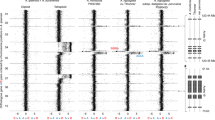Abstract
IT is generally considered that differentiation of the hexaploid species of oats has resulted primarily from structural changes and gene mutations involving a small group of chromosomes more or less common to all the species. The different species hybridize readily, giving highly fertile progenies, which indicates considerable homology of the chromosomes of any one species with the others. Indeed, it would be difficult to discover a closer chromosome affinity in any group of polyploids than that indicated by Nishiyama1 for the four hexaploid oat species Avena byzantina, A. fatua, A. sterilis and A. sativa. With complete affinity between any two species represented as 1.000 and no affinity as 0.000, values obtained by Nishiyama from crosses involving the above-mentioned species ranged from 0.983 to 0.998. More recently, however, cytological studies conducted by Joshi and Howard2 show that meiotic irregularities are found in fairly high frequencies in hybrids with A. byzantina as one parent, which implies that at least some of the corresponding chromosomes of the various species are not completely homologous.
This is a preview of subscription content, access via your institution
Access options
Subscribe to this journal
Receive 51 print issues and online access
$199.00 per year
only $3.90 per issue
Buy this article
- Purchase on Springer Link
- Instant access to full article PDF
Prices may be subject to local taxes which are calculated during checkout
Similar content being viewed by others
References
Nishiyama, I., Jap. J. Genet., 5, 1 (1929).
Joshi, A. B., and Howard, H. W., J. Agric. Sci., 46, Pt. 2, 183 (1955).
Haussknecht, C., Mitt. Geogt. Gessel. Jena, 3, 231 (1885).
Thellung, Von A., Vjschr Natur. Gessel., Zurich, 56, 293 (1912).
Coffman, F. A., J. Amer. Soc. Agron., 38, 983 (1946).
Vavilov, N. I., Bull. App. Bot. and Plant Breed., 17 (2), 139 (1926).
Malzew, A. I., Bull. App. Bot., Leningrad, 38, Supp. (English translation, 473) (1930).
Author information
Authors and Affiliations
Rights and permissions
About this article
Cite this article
GRIFFITHS, D., JOHNSTON, T. Origin of the Common Wild Oat, Avena fatua L.. Nature 178, 99–100 (1956). https://doi.org/10.1038/178099a0
Issue Date:
DOI: https://doi.org/10.1038/178099a0
Comments
By submitting a comment you agree to abide by our Terms and Community Guidelines. If you find something abusive or that does not comply with our terms or guidelines please flag it as inappropriate.



